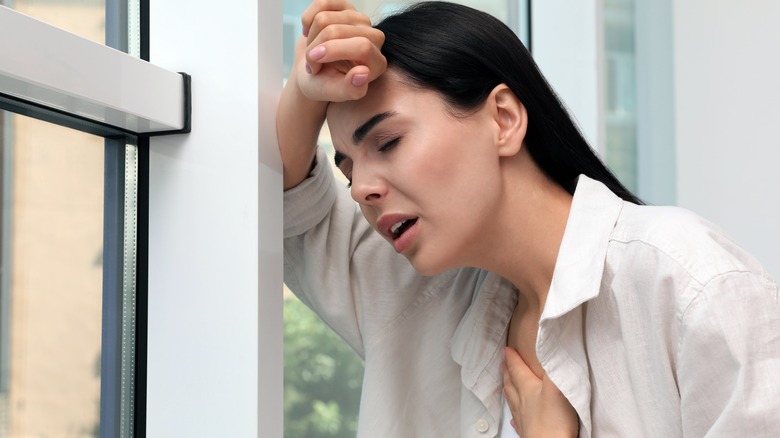How To Know If Your Panic Attacks Could Indicate A Larger Panic Disorder
Panic disorder is a type of anxiety disorder characterized by recurring and unexpected panic attacks, per the Mayo Clinic. Panic attacks are sudden and intense episodes of fear or discomfort that can happen without warning.
The exact causes of panic disorder are not fully understood, but it is believed to be caused by genetic and psychological factors. People with a family history of anxiety disorders are more likely to develop panic disorder, suggesting that there may be a genetic component, says Johns Hopkins Medicine. Environmental factors such as stress combined with a tendency for the body to overreact to that stress can also contribute to the development of panic disorder.
According to a 2023 study published in the International Journal of Mental Health and Addiction, the prevalence of panic disorder in the United States is between 4.7% and 5.0%. Indeed, the condition impacts millions of people in the U.S. and is more common in women, with them being four times more likely than men to have a panic attack, the study reveals. Panic disorder often develops in early adulthood, with the median age of onset being 20-24 years old, per the American Psychiatric Association. While panic disorder can develop at any age, it is most common in young adults.
Without treatment, panic disorder can be a chronic and debilitating condition that can significantly reduce your quality of life. If you experience frequent panic attacks that interfere with your daily life it may be a sign of panic disorder.
Signs your panic attacks might be panic disorder
As mentioned, having recurrent and unexpected panic attacks is the hallmark symptom of panic disorder. If you are experiencing panic attacks regularly and cannot identify a specific trigger, this may indicate a panic disorder as well. Other signs include physical symptoms such as chest pain, shortness of breath, and rapid heartbeat. These symptoms can be distressing and disruptive. Panic disorder can also cause impaired functioning in your daily life and interfere with your ability to work, socialize, or engage in other activities.
Fear of future panic attacks is also common with panic disorder. You might also experience anticipatory anxiety and avoid certain situations or places because you fear having a panic attack. Over time, this may lead to social isolation and reduced quality of life.
Finally, panic disorder often co-occurs with other mental health conditions such as depression or substance abuse. If you have a history of these conditions or have symptoms that suggest their presence, it is always best to discuss them with a mental health professional who can evaluate your symptoms and provide a diagnosis. They can help develop a personalized treatment plan for you so that you can learn to manage your symptoms better and improve your quality of life.
How is panic disorder treated?
Treatment for panic disorder typically involves a combination of therapy, medication, and lifestyle changes.
One of the most common treatments for panic disorder is cognitive-behavioral therapy (CBT). CBT is a type of therapy that helps individuals learn new ways to think about and respond to anxiety-provoking situations, per the Mayo Clinic. CBT is commonly used to treat various mental health conditions, including depression, anxiety disorders, post-traumatic stress disorder (PTSD), obsessive-compulsive disorder (OCD), and eating disorders. Over time, you can learn to manage your anxiety more effectively and reduce the frequency and intensity of panic attacks.
In addition to therapy, medications may also be used to treat panic disorder. Antidepressants, such as selective serotonin reuptake inhibitors (SSRIs), are often prescribed to help manage symptoms of panic disorder, per the Mayo Clinic. Benzodiazepines, such as Xanax or Ativan, can also be used in the short term to provide rapid relief from anxiety symptoms. However, benzodiazepines can be habit-forming and are generally not recommended for long-term use.
Lifestyle changes can also help manage symptoms of panic disorder. Regular exercise, reduced caffeine intake, and sufficient sleep can help reduce anxiety and stress levels. Practicing relaxation techniques, such as deep breathing and progressive muscle relaxation, can also be helpful in managing anxiety symptoms.



